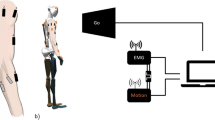Abstract
Simulation of natural human movement has proven to be a challenging problem, difficult to be solved by more or less traditional bio-inspired strategies. In opposition to several existing solutions, mainly based upon deterministic algorithms, a data-driven approach is presented herewith, which is able to grasp not only the natural essence of human movements, but also their intrinsic variability, the latter being a necessary feature for many ergonomic applications. For these purposes a recurrent Artificial Neural Network with some novel features (recurrent RPROP, state neurons, weighted cost function) has been adopted and combined with an original pre-processing step on experimental data, resulting in a new hybrid approach for data aggregation. Encouraging results on human hand reaching movements are also presented.
Preview
Unable to display preview. Download preview PDF.
Similar content being viewed by others
References
Y. Bellan, M. Costa, L. Macchiarulo, E. Pasero, “Task-Oriented Estimation Of Trajectories in Human Reaches”, Proc. of the NN&B, Beijing, CN, 1998.
S. Brandt, Statistical and Computational Methods in Data Analysis, North-Holland Publishing Company, Amsterdam, pp. 191–239, 1976.
M. Costa, F. Lombardi, A. Montuori, “A data driven methodology for the simulation of human movement in CAD environments”, Proc. of the CIRP International Seminar on Intelligent Computation in Manufacturing Engineering-ICME 98, Capri (Naples), IT, 1998.
H. Cruse, “On the cost functions for the control of the human arm movement”, Biol. Cybernetics, 62, pp. 519–528, 1990.
G. Ferrigno, A. Pedotti, “ELITE: a digital dedicated hardware system for movement analysis via real-time TV signal processing”, IEEE Trans. Biomed. Eng. (BME), 32, pp. 943–949, 1985.
G. Ferrigno, A. Pedotti, “Modularly expansible system for real-time processing of a TV display, useful in particular for the acquisition of coordinates of known shapes objects”, US Patent No. 4,706,296 (1987).
G. Ferrigno, N. A. Borgese, A. Pedotti, “Pattern recognition in 3D automatic human motion analysis”, ISPRS Journal of Photogrammetry and Remote Sensing, 45, pp. 227–246, 1990.
J. C. Fiala, “A network for learning kinematics with application to human reaching models”, Proc. of the ICNN, vol. 5, pp. 2759–2764, Orlando, FL, 1994.
T. Flash, N. Hogan, “The co-ordination of the arm movements: an experimentally confirmed mathematical model”, Journal of neuroscience, 7, pp. 1688–1703, 1985.
J. M. Hollerbach, T. Flash, “Dynamic interactions between limb segments during planar movements”, Biol. Cybernetics, 44, pp. 66–77, 1982.
D.W. Marquardt, Journal of the Society for Industrial and Applied Mathematics, vol. 11, 1963.
A. Pedotti, G. Ferrigno, “Opto-electronic based system”, in Three dimensional analysis of human movement, P. Allard, I.A.F. Stokes and J.P. Bianchi, pp. 57–77, Human Kinetics Publishers, 1995.
W.H. Press, S.A. Teukolsky, W.T. Vetterling, B.P Flannery, Numerical Recipes in C: The Art of Scientific Computing, Cambridge University Press, pp. 681–688, 1988.
M. Riedmiller, H. Braun, “A Direct Adaptive Method for Faster Backpropagation Learning: The RPROP Algorithm”, Proc. of the ICNN, San Francisco, CA, 1993.
Y. Uno, M. Kawato, R. Suzuki, “Formation and control of optimal trajectory in human arm movement”, Biol. Cybernetics, 61, pp. 89–101, 1989.
P. J. Werbos, “Backpropagation Through Time: What It Does and How to Do It”, Proc. of the IEEE, vol. 78, n. 10, 1990.
Wolf, “Elements of photogrammetry”, McGraw-Hill, New York, 1974.
Author information
Authors and Affiliations
Editor information
Editors and Affiliations
Rights and permissions
Copyright information
© 1998 Springer-Verlag Berlin Heidelberg1998
About this paper
Cite this paper
Bellan, Y. et al. (1998). Artificial Neural Networks for Motion Emulation in Virtual Environments. In: Magnenat-Thalmann, N., Thalmann, D. (eds) Modelling and Motion Capture Techniques for Virtual Environments. CAPTECH 1998. Lecture Notes in Computer Science(), vol 1537. Springer, Berlin, Heidelberg. https://doi.org/10.1007/3-540-49384-0_7
Download citation
DOI: https://doi.org/10.1007/3-540-49384-0_7
Published:
Publisher Name: Springer, Berlin, Heidelberg
Print ISBN: 978-3-540-65353-0
Online ISBN: 978-3-540-49384-6
eBook Packages: Springer Book Archive




